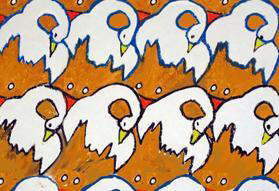Goal (Terminal Objective):
Design
Objective:
Students will demonstrate the ability to organize knowledge and ideas for the expression and production of art. Students will identify the sources for art expression and describe the processes artists use in developing their ideas. The student will become aware of logical relations and visual effects in progressive rhythm by creating an Escherlike design using positive and negative space.
National Standards:
Visual Arts Grades 9-12 Content Standard 1: Understanding and applying media, techniques, and processes
Visual Arts Grades 9-12 Content Standard 2: Using knowledge of structures and functions
Visual Arts Grades 9-12 Content Standard 3: Choosing and evaluating a range of subject matter, symbols, and ideas
Purpose:
Students will use simple symbolism to express a word with visual information. They will develop their creativity, visual ability, and abstract thinking ability. They will learn how to use basic compositional concepts and gain understanding in the use of composition. The student will become aware of the relationship between artistic and mathematical conceptual thinking.
Students will study the work of M.C. Escher and mathematical tessellations using that information to compose a repeat design pattern with oil pastels.
New Vocabulary:
Tessellation, positive shape, negative shape, repeat, complimentary, contrast, detailed, texture, pattern
Materials:

#22-1908 Washable Glitter Glue
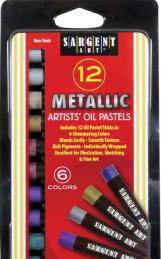
#32-2007 Metallic Oil Pastel
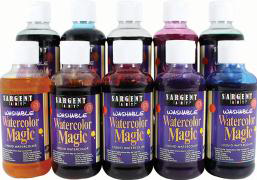
#22-6010 Washable Watercolor Magic
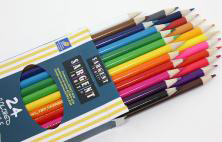
#22-7224 Colored Pencils
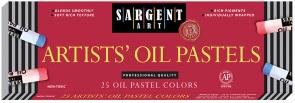
#22-2018Standard Size Oil Pastel
Time:
This lesson may be modified from one to five hours, depending upon the size and complexity of expectations.
Introduction and Motivation (Set):
View referenced websites to analyze exemplars of the work of M.C. Escher, focus on tessellations. (Metamorphosis, woodcut, 1937; Creation of a Metamorphosis) Note to students that before his work became wellknown, only mathematicians and scientists were interested in the prints of M.C. Escher.
Examine examples graphic design of M.C. Escher. Discuss and describe tessellations as designs in which positive and negative shapes and space are of equal importance. Escher found that the spaces between his shapes were just as important as the shapes (motifs) themselves.
Discuss the origin of the word Tessellation comes to us from Latin Tessella, which was the small, square stone or tile used in ancient Roman mosaics. Note how mosaics are common synonyms for tessellations. Much like a Roman mosaic, a plane tessellation is a pattern made up of one or more shapes, completely covering a surface without any gaps or overlaps.
Instruction:
View examples of the graphic design of M.C. Escher, focus on Tessellations. Brainstorm possible themes for motifs.
Activities:
(1) Guided Practice:
- Students prepare a 12 x 18” sheet ofpaper.
- Draw horizontal lines on the 12×18” paper 3” apart.(A)
- Draw diagonal lines from the top right corner to the bottom left again 3” apart.(B)
- For the third set of parallel lines, begin by placing the ruler at the points where the first two sets intersected.(C)
- A curved line will be drawn at the horizontal top of one triangle left to right.(D)
- Carefully redraw that curved line at the top of alltriangles.
- On the left side of the original triangle draw a noncurvedline from top to bottom. (E) This line was carefully redrawn at the top of all triangles. On the right a combination curved and straight line was drawn top to bottom.
- Erase grid lines. Students can look for something in their shapes, rotating their papers upside down right, left and rightside up. A few details can be added to help viewer identify the creature, animal orobject.
- Choose color scheme fordesign.
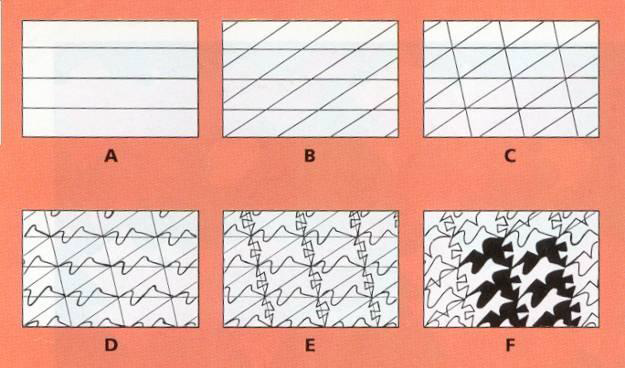
Alternative Design Process:
- Students generate motif sketch (approximately 3” square), duplicate on stiff paper, andcut out.
- Students trace motif pattern onto 12 x 18” paper, making sure one part of the motif touches the previously drawn motif pattern at the same point, taking care to keep the rows straight.
- Students add a detail to the traced motif at the same place on each drawn motif in the pattern.
- Students identify an alter motif in the negative spaces created by tracing the initial drawn motif.
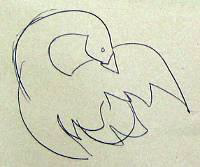
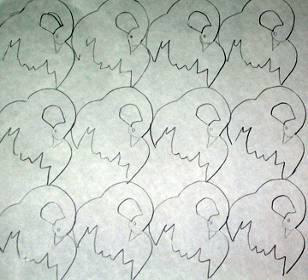
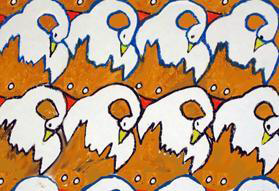
(2) Independent Practice and Check for Understanding: Teacher circulates among working students visually recording students demonstrating understanding of objectives and provides reinforcement.
- Students use Sargent Artists Oil Pastels or Gallery Metallic Oil Pastels to add a varietyof colors to create visual interest to their repeat designtessellation.
- Students use a wash of Sargent Watercolor Magic to fill in those areas not covered by oil pastels.
(3) Closure:Students record either by checklist or writing prompt, the motif identified in their positive and negativespaces.
Evaluation:
Teacher/student critique and/or individual evaluation.
Review the concept that artists often find new ideas by experimenting with media. Analyze individual success of the design process.
Compare design with art exemplars for use of elements of design and principles of organization. Describe and identify the process for creating a tessellation.Judge how the principles of unity, harmony and variety are used in the design. Which shapes will tessellate? Why will certain shapes tessellate and others not? Do tessellating designs have symmetry? If so, what kind?
Extension:
Discuss what makes Escher’s prints and tessellations seem mathematical. View the works of other students and discuss the shapes identified in their tessellations.
View works of Escher dealing with transformations. View the work of other artists who deal with optical illusions, transformations, and repetitive design, i.e. Bridget Riley, Rene Magritte, and Andrea Mantegna
Resources:
http://www.mcescher.com/
http://en.wikipedia.org/wiki/M._C._Escher
http://www.mathacademy.com/pr/minitext/escher/
Art Consultant



